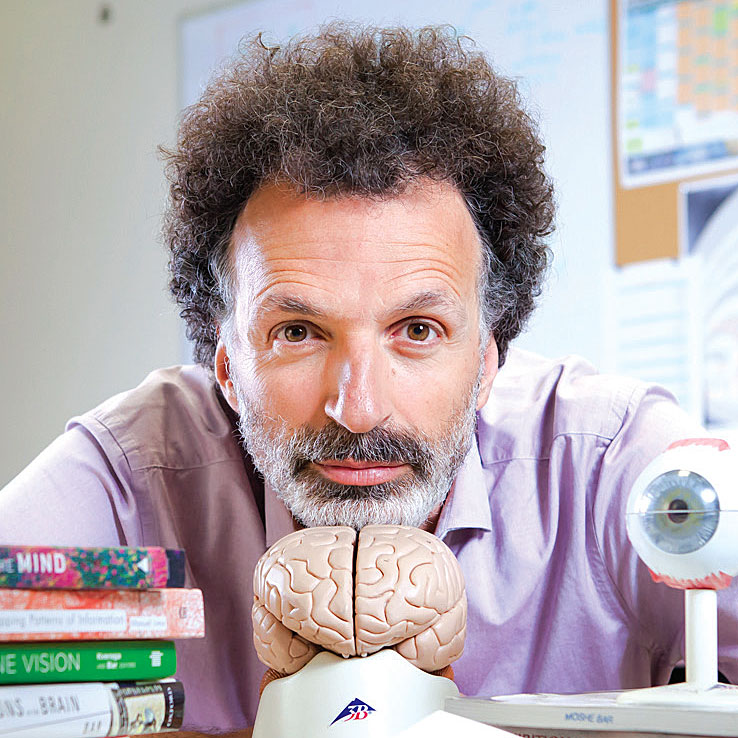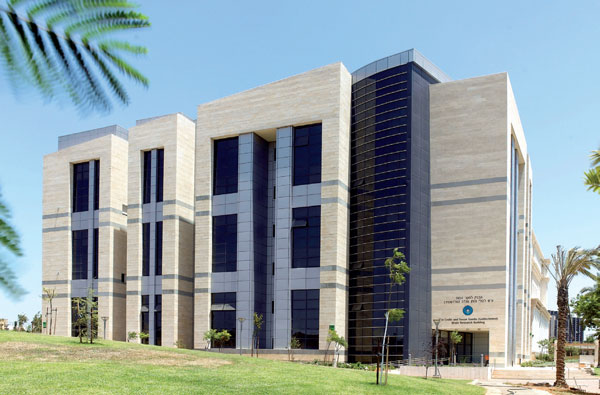Ramat Gan, Israel -
The Jerusalem Report has published a cover story profile of Bar-Ilan Professor Moshe Bar and his work in the field of brain research. The article by Brian Blum covers several areas of his research as well as Bar’s career path.
Raising the Bar
The brain scientist who studies the past to predict the future
By Brian Blum
Courtesy of The Jerusalem Report
PROF. MOSHE BAR has ADHD and is proud of it.
“I don’t see ADHD as a disorder,” he explains. “It confers advantages. It’s nature’s way of enriching diversity, so that not everyone thinks the same way.”
Bar’s accepting approach to ADHD is emblematic of the kind of cutting-edge thinking that has made him one of the most sought-after brain scientists in the world. The head of the Gonda Multidisciplinary Brain Research Center at Bar-Ilan University for the past eight years, Bar has published widely on a head-spinning variety of subjects – the relationship between memory and foresight, mental load and mind wandering, mood and creativity, even how to build “conscious cities.”
“That’s my ADHD,” he jokes. “I’m all over the place. I have articles on architecture, aesthetics, urban design – I just follow my interest and do whatever I can until my interest is saturated.”
Bar is an iconoclast not just in his out-of-the-box embrace of ADHD; he was quoted a few years ago as saying that anxiety helps one deal better with the realities of life.
“Someone took something I said a little too far,” he counters. “I don’t recommend being too anxious. But even though it almost sounds cynical, there is some truth to it – that depressed people see the world as it is. Everyone else, in this view, is delusional.”
To back up the claim, Bar points to a 1979 experiment where two groups – one of mildly depressed individuals and the other composed of healthy subjects – were asked to press a button that sometimes did (and sometimes did not) seem to operate a light bulb.
When asked how much control they thought they had over the light, the non-depressed participants thought they had about 75% control,” Bar says. “The depressed group reported that they had none, and they were right – the button was not even connected to the light!”
Understanding how the brain works has been at the center of Bar’s career for the past three decades, one that began in Israel where he received a bachelor’s degree in electrical engineering from Ben-Gurion University of the Negev in 1988, and a master’s in computer science and applied mathematics from the Weizmann Institute of Science in 1994. It continued in the U.S. where he graduated from the University of Southern California with a PhD in psychology in 1998, subsequently landed his dream job as the director of the Cognitive Neuroscience Laboratory at Harvard Medical School, and then took a decision in 2011 that surprised his American colleagues when he came back to Bar-Ilan University.
“Many people raised eyebrows when I returned,” the 54-year-old Bar tells The Jerusalem Report. “People are always talking about the brain drain from Israel and here I was, going in the opposite direction. I made an Excel sheet with the pros and cons of Israel vs. the U.S., and everything in the U.S. came out better in terms of education, salary, security, the size of my house. I closed my laptop and went against everything the chart said.”
It was a gut decision, he admits, driven by a desire to be closer to family and raise his children in Israel. But there was a professional aspect as well.
“There are not many places you can climb to after Harvard,” he says. “So I thought, can I come to a place that’s home and maybe bring something from the US here – an international perspective, connections from the 17 years I lived in the U.S.?”
Remembering the Past to Predict the Future
Bar’s most important contribution to brain science has been identifying the role of memory.
“Before I studied it, I thought of memory as a big photo album, which you pull out to reminisce on your kids’ bar mitzvahs or a trip to Europe, and sometimes also to dwell on negative memories,” he says.
It turns out that memory is more a survival tool than an entertainment platform.
“The main function of memory is to help the brain predict, to prepare for upcoming events and encounters,” Bar explains. “In order to anticipate, you have to lean back on memory. We do it all the time. We make hundreds of decisions every day. Not all of them are big. It could be whether to order cheesecake or chocolate cake.”
So for example, we gravitate toward ordering the chocolate cake because we can imagine the taste from stored experience. We know what to pack when going to the beach because we’ve done it before. When the phone rings and an unfamiliar person asks how you’re doing, the background noise tells you it is a telemarketing call.
“It does not matter that it is a new person or that what he is offering is new to you,” Bar wrote in The Los Angeles Times. “The situation is similar to many you have already experienced. [So] you execute the same series of actions you have executed numerous times before,” such as apologizing for being too busy to talk – or simply hanging up. This ability to use memory to generate predictions “saves us a lot of time and energy, and in some cases, saves our lives.”
The brain is also a “spectacular screen-writer,” Bar says. You don’t necessarily have to have experienced something personally in order to predict it.
“What would you do if upon landing [at the airport] you discover that the airline has lost your luggage and you are scheduled to give a talk in two hours,” he ponders. “It has not happened, but if it does, you will be ready. If you ran this simulation in your mind early enough, you might have packed extra clothes and other essentials for your talk in your carry-on.”
This kind of “mind wandering” can actually be studied in an fMRI (functional magnetic resonance imaging) scanner. In 2015, Bar conducted an experiment in which participants were treated with transcranial direct current stimulation (tDCS), a painless procedure that uses low-level electricity to stimulate specific brain regions in order to simulate a kind of daydreaming. Participants were then asked to track and respond to numbers flashing on a computer screen.
The results, which were published in the Proceedings of the National Academy of Sciences, found that the external day-dreaming stimulus, counter-intuitively, increased the ability of participants to stay on task. “It actually enhanced the subjects’ cognitive capacity,” Bar reports.
The converse is also true: “Stray thoughts, obsessive rumination and other forms of ‘mental load’ [reduce] the capacity for original and creative thinking,” Bar reported in an article he wrote for The New York Times.
Bar tested this theory as well: he gave participants a free-association task while taxing their minds to different degrees. In one experiment, participants were asked to remember a seven-digit string of numbers, then when given a word (for example, “shoe”) to respond as quickly as possible with the first word that came to mind (say, “socks”). The researchers tried the same experiment with participants who only had to remember two digits.
“We found that a high mental load consistently diminished the originality and creativity of the response,” Bar says. Participants who had to remember the seven-digit string might associate the word “white” with “black,” while those with just two digits to recall could be more creative, coupling “white” with “cloud.”
Bar’s work is not simply obscure research meant mainly for querying in a brain lab. Rather, it is eminently practical – our minds are constantly getting cluttered, whether it’s memorizing a list of groceries, rehearing the name of someone you just met, or practicing a pitch before an important meeting. When occupied, the mind “looks for the most familiar and inevitably least interesting solution,” Bar says.
Have social media and the invasive notifications on our smart devices irreparably altered our ability to cope with always-on mental clutter?
“I don’t share the doomsayer attitude about social media that some people tend to adopt,” Bar says. “It’s not addictive. My daughter went to camp and for two months had no screens and was happy about it. She didn’t show any withdrawal symptoms. When she came back, of course, she was glued to the screen again.”
Mental load is all around us – even in the way we design our cities. Bar suggests that walking through a busy street exposes us to so many stimuli – advertising, people, sounds and smells – that it can diminish our ability to pay attention and handle stress. In a 2018 paper Bar co-authored with Israeli architect Itai Palti, the two outlined how creating “conscious cities” can alleviate anxiety “by being sensitive to the pervading moods and personalities of people in different parts of the city at different times of day and night.”
One example: Sporting matches too often end in violence or vandalism when crowds exit a stadium all at once. The social science theory behind this is called “deindividuation,” and it explains why individuals behave differently in large groups. Bar and Palti propose funneling fans into situations unrelated to the event that “prompt social interactions that prevent deindividuation.”
Another example: Buildings with purposely planned greenery can have a “restorative influence on cognitive abilities,” something the two have dubbed “conscious architecture.”

Bar has his own solution to recharge his frequently overloaded mind: he takes a week off every year to attend a seven-day mindfulness meditation retreat.
“Being silent for a week is not for the faint of heart,” Bar cautions. But the results can be invigorating. “My thoughts, when I returned to the act of thinking about something rather than doing nothing, are fresher and more surprising.”
Are You in the Mood?
Bar has also looked at the relationship between mood and creativity. He had already shown how depressed people may be more likely to see the world “as it is.” What he also discovered is that depressed individuals are less “associative,” where you connect the mental dots and put together how one thing goes with another. A less associative mind, in turn, makes it difficult to project what will happen in the future, a key component of creativity.
The flip side: More associative or creative thinking elicits a positive mood. While Bar stresses that it’s still premature to talk about specific solutions, he is studying whether “if we cause people to be more associative, it will improve their mood,” without the need to resort to medication.
One way to almost always guarantee a better mood: do something out of the ordinary. “The brain immediately identifies new as valuable,” Bar explains. But there needs to be a balance between “exploration” and “exploiting” what we already know. “We tend to be more exploratory when traveling to a new country, whereas we are more inclined toward exploitation when returning home after a hard day at work.”
That tension is built into evolution: if we were not explorers, early humans never would have ventured out of our prehistoric caves, he notes. On the other hand, “if we did not exploit the certainty of the familiar, we would have taken too many risks and gone extinct. Much of our lives is spent somewhere between those extremes.”
Bar’s journey toward brain research started during his service in the Israel Air Force, where he became interested in the field of image processing and computer vision. The military allowed him to take off one day a week to study for his master’s degree.
“In computer vision, we’re trying to imitate how something works in the brain, but I soon realized that no one understood how real vision works,” he recalls.
Bar’s career switch into cognitive psychology was at first a way for him to probe the nature of human vision.
“How does one understand what an object is when you first see it?” he wondered. The answer, he surmised, was that objects don’t appear in isolation. “We see them in context. If you go into the kitchen, you expect to see with some probability a refrigerator, an oven, a sink. The brain takes advantage of this, so the next time you enter a kitchen, the brain can predict what to expect.” The same is true whether it’s a cocktail party or a visit to an unfamiliar synagogue.
That led to his groundbreaking work – and the production of dozens of research papers and talks at academic conferences on memory and predictions.
Could Bar have foreseen his own career path?
“I wish I could say my profession was carefully selected after many simulations,” he says, “but really, I was going in multiple directions, and in each specific moment I chose what was the most interesting. I feel very lucky being a scientist of the mind, to be able to study how people behave and how it affects their fellow human beings.”
Moreover, mental pain can be similar to physical pain, he says. “If I and my fellow neuroscientists can develop something to alleviate some of that human suffering, that’s a noble cause.”
The writer’s book, TOTALED: The Billion-Dollar Crash of the Startup that Took on Big Auto, Big Oil and the World, is available on Amazon and other online booksellers




